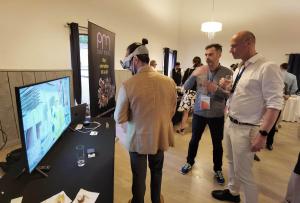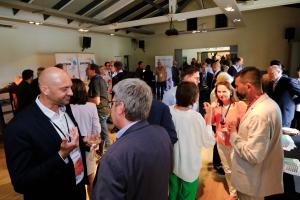Suppliers see growing opportunities
A diverse group of suppliers described their roles in a growing ecosystem around nuclear fusion and shared their vision of the future.
The quest for fusion brings together a wide range of supplier organizations from around the world, and with the global fusion supply chain projected by some to grow from EUR 460 million today (USD 500 million) to over EUR 6.5 billion (USD 7 billion) in the 2030s, the potential for companies is enormous.
On day one of the ITER Private Sector Fusion Workshop last week, attendees got a taste of the diversity of offerings, as suppliers and partners set up tables at the evening event to explain their products and services. These organizations represent the growing ecosystem—everything from IDOM (a company that runs large construction and engineering projects) to consulting firms LT Calcoli (a specialist in numerical engineering analysis) and digiLab (a provider of AI solutions for energy, engineering, and transport projects).
Some of the suppliers at the event said that while fusion only accounts for a small part of their business, they expect to grow within the industry even before it becomes a commercial reality. "Fusion is less than 1% of our revenue now," said Gianni Di Maio of CAEN SpA, a provider of electronic components, including power supplies and read-out electronic diagnostics. "We would like to find new ways of collaborating to increase our participation within ITER and the fusion ecosystem more generally."
Other suppliers have already seen the fusion part of their business grow dramatically. "We have been associated with ITER for around 15 years," said Vijay Gehani, of the Cryo Scientific Division in INOX India, one of the industry leaders in cryogenic storage solutions and cryo-distribution systems. "While fusion is still only a small part of our revenue, we have seen remarkable year-over-year growth in that part of our business."
Some of the partners started working in the industry with ITER and were able to move on to other fusion projects. "We have been working for ITER project continuously for more than 15 years, from prototyping to series production of different components, successfully delivering 70 radial plates and 10 toroidal field coils," said Marianna Ginola, SIMIC S.p.a. "At the moment we have contracts with Commonwealth Fusion Systems, but we are collaborating and in discussion with many other fusion companies."
Similarly, Ignition Computing began working on fusion five years ago, when they helped develop simulation software for ITER. "The proportion of our work that is for fusion has rapidly increased, with ITER now responsible for the majority of our turnover," says CEO Daan van Vugt. "As of this year, we are now also working for Pacific Fusion, a US-based fusion startup."
Some of the suppliers at the event work in both fusion and fission. One of them was Bhukhanvala Industries, who make engineered ceramics for ITER. CEO Niraj P. Bhukhanwala said, "We expect our business to grow both from fusion and SMR [small modular reactors]."
Others have already developed tools and techniques that they marketed to industries beyond nuclear energy. Cosylab, for example, acquired skills building a standardized development environment for hundreds of control systems at ITER that they have since used to develop a complete software suite and integration services for radiation therapy devices that fight cancer. And Dawonsys, a supplier of AC/DC converters and high voltage power supplies at both ITER and KSTAR, successfully applied what they developed for fusion to two completely different industries. One is rolling stock, where they provided an inverter-based propulsion control unit and improved welding processes to large locomotives. The other is healthcare, where they integrate power electronics and control technology in accelerator-based BNCT cancer-therapy devices.
Two of the organizations that presented have a mission to bring players together and connect the dots. Fusion Energy Insights (FEI) helps grow the ecosystem by bringing more people into fusion. "We want to help people understand that fusion is coming and that there are opportunities for their business," said CEO Melanie Windridge. And FuseNet, the European Fusion Education Network, provides support to students in fusion science and fusion engineering by sharing information about working in the fusion ecosystem, including in industry, during and after training.
Connecting the dots was one of the goals of the event—and all suppliers seemed to appreciate the opportunity to meet other players in the ecosystem. "It was great to meet in person with people working in the same field and exchange information," said Marcin Orzechowski, CEO of Bimo Tech, a supplier of components and special metals—including rhodium targets, titanium and stainless steel 316LN-IG.
The new contacts will surely help Bimo Tech on its way up the value chain. "Since we started working with ITER, we've learned a lot about fusion," says Orzechowski. "We pushed our manufacturers to reach the limits set by technical specifications. We learned about how it all fits together—and we now plan to build our own experimental fusion device within the next ten years."




